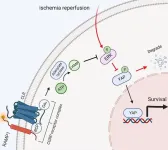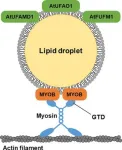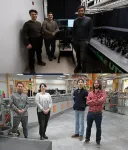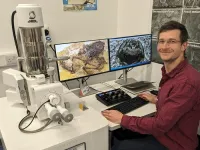(Press-News.org) Electronic devices are getting more and more complex as they are built to carry out an ever-increasing number of functions. This can be seen in the increased functionality in our personal devices such as our phones, tablets and watches, let alone in industrial devices. However, their growing complexity can lead to performance and safety issues. These issues include device overheating or emitting microwaves that can result in health issues and that can reduce a device’s performance and interfere with other devices.
Chinese scientists from Beijing Normal University have been working on building shielding for electronic devices using multifunctional composite phase change materials (PCMs) to address these performance issues. PCMs are man-made materials built by combining different types of elements, allowing the creation of a new material with very specific purpose driven characteristics. In this case the researchers are looking to improve thermal management, solar-thermal conversion and microwave absorption in the electronic devices.
Using engineering inspired by biological systems, a bionic design, they built a neural network-inspired aerogel that increases the efficiency of thermal management and the absorption of microwave emissions.
“Our developed functionally integrated composite PCMs provide a prospective application of highly integrated and miniaturized electronic devices in complex and changeable outdoor environments,” said Xiao Chen, a researcher from the Institute of Advanced Materials, Beijing Normal University, China.
This research was published on April 3 in Nano Energy Research.
To ensure it had the necessary properties—improved thermal management which optimizes heat dissipation and heat storage, solar-thermal conversion which allows devices to heat up for normal start-up in cold environments, and microwave absorption—the researchers very carefully chose the elements that would be incorporated into their new aerogel shield. Given the space limitations, they could not layer the different materials, so they needed to create a new composite material with all the necessary properties.
The researchers knew that “thermally enhanced PCMs have the ability to store and release massive energy as latent heat, they are widely acknowledged for the ability to ensure precise temperature control,” said Yang Li, first author on the paper and researcher at the Institute of Advanced Materials, Beijing Normal University, Beijing, China. These composites can undergo phase change as the temperature increases from solid to liquid, which increases the available heat storage, and when the temperature cools the liquid reverts to solid. However, while pure PCMs do not show promise in solar-thermal conversion, “bacterial cellulose (BC) is a highly desirable natural biomass due to its numerous advantages including biodegradability, low cost, high purity, renewability, easy modification and functionalization. BC-derived carbon nanofiber through high temperature carbonization has been considered as a promising solar-thermal material.”
Another element would be used to address the issue of microwave emissions. “Recent interest in microwave absorption has focused on metal-organic frameworks due to their exceptional porosity, adjustable pore structure and high specific surface area,” said Ge Wang, from the School of Materials Science and Engineering, University of Science and Technology Beijing, China. “Numerous studies have demonstrated that a porous network structure not only provides large specific surface area for absorbing PCMs, but also dissipates microwave energy through scattering or multiple reflection.”
Finally, the material was encased in paraffin wax, which can undergo phase change, as a method of thermal storage. The final material was then tested to see how well the composite hybrid aerogel maintained the desired characteristics.
When testing for solar-thermal conversion to determine how well the composite could store solar energy for heating a device in colder climates, the aerogel-based composite PCMs showed over 90% absorption of broadband and the full light spectrum. It converted solar energy into thermal energy with a greater than 95% efficiency and showed a thermal storage capacity of 122.19 J/g. Finally, when the microwave absorption was tested, the incident electromagnetic waves were efficiently absorbed by the aerogel-based composite PCMs.
The researchers concluded “our bionically fabricated high-performance and functional integrated aerogel-based composite PCMs with thermal management, solar-thermal conversion and microwave absorption functions show a good prospective application in overcoming overheating or overcooling and EMI of electronic devices,” said Xiao Chen.
Other Contributors
Panpan Liu, Yuhao Feng and Xuemei Diao from the Institute of Advanced Materials, Beijing Normal University, Beijing, China and the College of Nuclear Science and Technology, Beijing Normal University, Beijing, China, Peicheng Li from the School of Environment, Beijing Normal University, Beijing, China, and Yan Gao from Beijing Advanced Innovation Center for Materials Genome Engineering, Beijing Key Laboratory of Function Materials for Molecule & Structure Construction, School of Materials Science and Engineering, University of Science and Technology Beijing, Beijing, China.
This work was financially supported by the National Natural Science Foundation of China.
About Nano Research Energy
Nano Research Energy is launched by Tsinghua University Press and exclusively available via SciOpen, aiming at being an international, open-access and interdisciplinary journal. We will publish research on cutting-edge advanced nanomaterials and nanotechnology for energy. It is dedicated to exploring various aspects of energy-related research that utilizes nanomaterials and nanotechnology, including but not limited to energy generation, conversion, storage, conservation, clean energy, etc. Nano Research Energy will publish four types of manuscripts, that is, Communications, Research Articles, Reviews, and Perspectives in an open-access form.
About SciOpen
SciOpen is a professional open access resource for discovery of scientific and technical content published by the Tsinghua University Press and its publishing partners, providing the scholarly publishing community with innovative technology and market-leading capabilities. SciOpen provides end-to-end services across manuscript submission, peer review, content hosting, analytics, and identity management and expert advice to ensure each journal’s development by offering a range of options across all functions as Journal Layout, Production Services, Editorial Services, Marketing and Promotions, Online Functionality, etc. By digitalizing the publishing process, SciOpen widens the reach, deepens the impact, and accelerates the exchange of ideas.
END
(Boston)—Mycobacterium tuberculosis, the bacteria that causes tuberculosis (TB), is distinct from most germs in its capacity to silently infect individuals for months and even years before waking up and causing active disease that can lead to severe illness and death. The immune system plays an important role in controlling the germ and keeping it dormant.
Decades of epidemiological data have linked undernutrition to TB. While undernourished individuals have blunted immune systems, a phenomenon which has been dubbed nutritionally acquired ...
In the field of aerospace, a high-temperature piezoelectric vibration sensor is one of the few key devices that can be monitored in a high-temperature and harsh environment, so it is particularly urgent to develop high performance high-temperature piezoelectric ceramics as the core component of this kind of sensor. Bi4Ti3O12 (BIT), as one vital type of bismuth layered structure ferroelectrics (BLSFs), has great application prospects in high-temperature environments due to its excellent TC of 675 ℃. However, the volatilization of Bi during the sintering process in BIT-based ceramics leads to the generation of oxygen vacancy ...
Background and Aims
Hepatic ischemia-reperfusion injury (HIRI) is a prevalent complication of liver transplantation, partial hepatectomy, and severe infection, necessitating the development of more effective clinical strategies. Receptor activity–modifying protein 1 (RAMP1), a member of the G protein–coupled receptor adapter family, has been implicated in numerous physiological and pathological processes. The study aimed to investigate the pathogenesis of RAMP1 in HIRI.
Methods
We established a 70% liver ischemia-reperfusion model in RAMP1 knockout (KO) and wild-type mice. Liver and ...
Thermophilic fungi are chief components of mycoflora in a variety of natural and manmade composting systems, including rotting hay, stored grains, wood mulch, nesting material of birds and animals, municipal refuse, and self-heating accumulated organic matter. Thermophilic fungi are also a potential source of natural products, which complement the metabolite libraries of mesophilic fungi and bacteria.
The research team led by Prof. Dr. Xuemei Niu (State Key Laboratory for Conservation and Utilization of Bio-Resources in Yunnan, Yunnan University) has been working on the discovery of secondary metabolites in thermophilic fungi and their biological ...
DALLAS, April 23, 2024 — Atrial fibrillation, or AFib, is the most common type of irregular heartbeat, estimated to affect about 12.1 million U.S. adults by 2030.[1] The abnormal firing of electrical impulses causes part of the heart to quiver, or fibrillate, often leading to complications and up to a fivefold increased risk of stroke. To help ensure all patients with AFib receive the most appropriate care, the American Heart Association is launching a new effort to educate and engage pharmacists, an important but underrepresented voice in AFib care.
This ...
We experience the world and connect with others through social interactions. Engaging in activities, such as conversations, cooperative tasks, and intimate relationships, deeply affect brain activity leading to coordinated neural activity within an individual's brain (intra-brain synchronization) and between the brains of multiple individuals (inter-brain synchronization).
Researchers study brain synchronizations to understand the neural processes behind social behaviors. This knowledge can help diagnose and treat conditions like social anxiety and communication-related disorders. However, investigations on brain synchronization ...
Lipids are biomolecules essential for the proper functioning of the living cell, ranging from comprising cell membranes to forming integral components of cell signaling pathways. Plant cells possess cell subcellular structures or organelles called lipid droplets (LDs) in the leaves and seeds, which store excess lipids (fats).
Recent studies have shown that LDs also localize unique plant proteins that perform essential molecular functions. For example, seed LDs localize plant proteins called oleosins, which help seeds weather freezing temperatures and germinate properly. With an expanding body of proof ...
NEW YORK, April 23, 2024 — Single-photon emitters (SPEs) are akin to microscopic lightbulbs that emit only one photon (a quantum of light) at a time. These tiny structures hold immense importance for the development of quantum technology, particularly in applications such as secure communications and high-resolution imaging. However, many materials that contain SPEs are impractical for use in mass manufacturing due to their high cost and the difficulty of integrating them into complex devices.
In 2015, scientists discovered SPEs within a material called hexagonal boron nitride (hBN). Since then, hBN has gained widespread attention and ...
Palaeontologists at University College Cork (UCC), Ireland, have solved a hundred-year-old mystery of how some fossil frogs preserve their fleshy parts – it’s all down to their skin.
Palaeontologists Daniel Falk and Prof. Maria McNamara, together with scientists from Ireland, Germany and the UK, studied 45-million-year-old fossil frogs from the Geiseltal site in central Germany. Remarkably, the fossils show full body outlines of the soft tissues. The team discovered that the excellent condition of the fossil frogs is due to preservation of ancient skin remnants.
The team studied the fossils with high-precision ...
Existing drugs studied in patients with rare immune diseases
This month the first study within the DRIMID consortium (DRIMID stands for Drug Rediscovery for Rare Immune Mediated Inflammatory Diseases) has started. This study will investigate the efficacy and safety of the drug filgotinib (approved for treatment of rheumatoid arthritis and ulcerative colitis) in three rare immune diseases (Behçet's disease, idiopathic inflammatory myositis, IgG4-related disease). DRIMID aims to investigate whether this drug - despite the absence of formal ...








